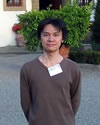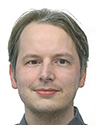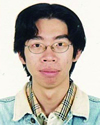We have a growing community of planetary scientists ASIAA who are involved in a wide range of research topics covering both theoretical modeling and observations of our own solar system and those of other stars.
For our own solar system, ASIAA is playing a leading role in two large surveys. The Transneptunian Automated Occultation Survey(TAOS II) aims to measure the size distribution of Trans-Neptunian Objects (TNOs) and objects in the Inner Oort Cloud. TAOS II will operate at the San Pedro Mártir Observatory in Baja California, Mexico. The survey will observe up to 10,000 stars simultaneously with three 1.3 m telescopes at a cadence of 20 Hz in order to resolve short duration (200 ms) occultation events by TNOs with diameters 300 m < D < 30 km. These objects are too faint to be observed directly, even with the largest telescopes. However, measuring the size distribution of these objects is critical to our understanding of the formation and evolution of the solar system. Furthermore, the target population of these observations is the source of the Jupiter Family Comets (JFCs), and a census of this reservoir is important to understand the dynamical processes by which these TNOs migrate into cometary orbits.
In addition to TAOS II, ASIAA is a major partner of the FOSSIL Survey (Formation of the Outer Solar System: An Icy Legacy). FOSSIL, an Intensive Program of the Subaru telescope using the Hyper Suprime-Cam (HSC) wide field camera, is a large international collaboration including Taiwan, Japan, South Korea, China, New Zealand, Canada, and the United States. The survey will cover 105 deg. 2 to as faint as r = 27 in order to detect and characterize small solar system bodies such as TNOs, Jupiter Trojans, Hildas, and Main Belt and Near Earth Asteroids. Phase I of the project, which aimed to measure the spin rates of JTs and Hildas, as well as measure the faint end size distributions of faint TNOs, JTs and Hildas, covered 30 deg. 2 of both the L4 and L5 JT clouds at a high cadence in order to measure the spin rates of JTs and Hildas in order to ascertain their internal structures (monolithic or gravitational aggregates), as well as detect very faint TNOs. Phase II of the proposal would concentrate on a three year survey of TNOs covering 75 deg. 2 to detect objects as faint as r = 26. By observing the objects over three years, the survey will be able to constrain their orbits sufficiently to classify them into their dynamical sub-populations. Color measurements will also be performed, which in conjunction with size distribution measurements and dynamical classifications, will allow the survey team to support or contravene the Planet 9 hypothesis, discover evidence of the formation histories of the different TNO dynamical classes, constrain models of the migration of Neptune and the collisional history of TNOs.
Several members of the planetary science group at ASIAA are performing large scale dynamical simulations of the outer solar system. In particular, investigation of the effect of the population of Dwarf Planets (DPs) in the Trans-Neptunian region has shown that they increase the migration rate of TNOs into cometary orbits relative to the rate found when only considering gravitational interactions with Neptune. In addition, DPs contribute to the long term instability of the orbits of many TNOs, leading to their eventual ejection from the solar system.
Similar simulations of the Centaur population have shown that some of these objects are in stable three-body resonances with Jupiter and Saturn. In addition, the orbits of the moons of Saturn, Pallene in particular, are being simulated to determine their resonant structures.
Outside of our solar system, the planetary science group at ASIAA is working on a wide range of topics, from protoplanetary and debris disks to evolved systems with exoplanets and exomoons. Observations of protoplanetary disks using the Atacama Large Millimeter/submillimeter Array (ALMA) are being used to discover and characterize various features in these structures such as gas rings, spiral inflow, pressure bumps, and disk eccentricities. Some of these features may be intimately related to planet formation processes, and it is thus important to learn as much as possible about these features.
Members of the ASIAA planetary science group are also involved in many aspects of debris disc studies, performing detailed multi-wavelength studies on the architectures of individual systems using ground- and space-based observing facilities such as ALMA, the Herschel space observatory, the Hubble Space Telescope (HST), and the Very Large Telescope (VLT) with the Spectro-Polarimetric High-contrast Exoplanet Research (SPHERE) facility, piecing together their evolution and searching for trends in the star/disc properties through systematic characterization of spatially resolved discs, modeling the composition of the constituent dust grains (and parent planetesimals) combining radiative transfer modeling and laboratory dust measurements, tracing the dynamical evolution of planetesimal belts under the influence of planetary companions, and searching for exocomets and their parent planetesimal belts around young stars in nearby open clusters.
Finally, significant research efforts are being made in the area of evolved planetary systems. Planet formation and evolution around FGKM dwarfs are being modeled to interpret Kepler/K2 data and to prepare for the science from the SPectropolarimètre InfraROUge (SPIRou) instrument on the Canada-France-Hawaii Telescope (CFHT). The theory of thermal tides is being investigated to examine whether this model can explain the anomalously large size of hot Jupiters. Simulations of the formation of short period exoplanets have led to the prediction of co-orbital planets, and subsequent work is now being done to examine the possibility of discovering such systems in data from the Kepler/K2 or the Transiting Exoplanet Survey Satellite (TESS) missions. Other research is focusing on exomoons, in particular, developing new approaches for identifying moon signals in Kepler/K2 and TESS data, as well as targeted observations using the HST or the James Webb Space Telescope (JWST). Recent work also includes modeling and interpreting the transit timing variations of planets hosting multiple moons.
We have a growing community of planetary scientists ASIAA who are involved in a wide range of research topics covering both theoretical modeling and observations of our own solar system and those of other stars.
For our own solar system, ASIAA is playing a leading role in two large surveys. The Transneptunian Automated Occultation Survey(TAOS II) aims to measure the size distribution of Trans-Neptunian Objects (TNOs) and objects in the Inner Oort Cloud. TAOS II will operate at the San Pedro Mártir Observatory in Baja California, Mexico. The survey will observe up to 10,000 stars simultaneously with three 1.3 m telescopes at a cadence of 20 Hz in order to resolve short duration (200 ms) occultation events by TNOs with diameters 300 m < D < 30 km. These objects are too faint to be observed directly, even with the largest telescopes. However, measuring the size distribution of these objects is critical to our understanding of the formation and evolution of the solar system. Furthermore, the target population of these observations is the source of the Jupiter Family Comets (JFCs), and a census of this reservoir is important to understand the dynamical processes by which these TNOs migrate into cometary orbits.
In addition to TAOS II, ASIAA is a major partner of the FOSSIL Survey (Formation of the Outer Solar System: An Icy Legacy). FOSSIL, an Intensive Program of the Subaru telescope using the Hyper Suprime-Cam (HSC) wide field camera, is a large international collaboration including Taiwan, Japan, South Korea, China, New Zealand, Canada, and the United States. The survey will cover 105 deg. 2 to as faint as r = 27 in order to detect and characterize small solar system bodies such as TNOs, Jupiter Trojans, Hildas, and Main Belt and Near Earth Asteroids. Phase I of the project, which aimed to measure the spin rates of JTs and Hildas, as well as measure the faint end size distributions of faint TNOs, JTs and Hildas, covered 30 deg. 2 of both the L4 and L5 JT clouds at a high cadence in order to measure the spin rates of JTs and Hildas in order to ascertain their internal structures (monolithic or gravitational aggregates), as well as detect very faint TNOs. Phase II of the proposal would concentrate on a three year survey of TNOs covering 75 deg. 2 to detect objects as faint as r = 26. By observing the objects over three years, the survey will be able to constrain their orbits sufficiently to classify them into their dynamical sub-populations. Color measurements will also be performed, which in conjunction with size distribution measurements and dynamical classifications, will allow the survey team to support or contravene the Planet 9 hypothesis, discover evidence of the formation histories of the different TNO dynamical classes, constrain models of the migration of Neptune and the collisional history of TNOs.
Several members of the planetary science group at ASIAA are performing large scale dynamical simulations of the outer solar system. In particular, investigation of the effect of the population of Dwarf Planets (DPs) in the Trans-Neptunian region has shown that they increase the migration rate of TNOs into cometary orbits relative to the rate found when only considering gravitational interactions with Neptune. In addition, DPs contribute to the long term instability of the orbits of many TNOs, leading to their eventual ejection from the solar system.
Similar simulations of the Centaur population have shown that some of these objects are in stable three-body resonances with Jupiter and Saturn. In addition, the orbits of the moons of Saturn, Pallene in particular, are being simulated to determine their resonant structures.
Outside of our solar system, the planetary science group at ASIAA is working on a wide range of topics, from protoplanetary and debris disks to evolved systems with exoplanets and exomoons. Observations of protoplanetary disks using the Atacama Large Millimeter/submillimeter Array (ALMA) are being used to discover and characterize various features in these structures such as gas rings, spiral inflow, pressure bumps, and disk eccentricities. Some of these features may be intimately related to planet formation processes, and it is thus important to learn as much as possible about these features.
Members of the ASIAA planetary science group are also involved in many aspects of debris disc studies, performing detailed multi-wavelength studies on the architectures of individual systems using ground- and space-based observing facilities such as ALMA, the Herschel space observatory, the Hubble Space Telescope (HST), and the Very Large Telescope (VLT) with the Spectro-Polarimetric High-contrast Exoplanet Research (SPHERE) facility, piecing together their evolution and searching for trends in the star/disc properties through systematic characterization of spatially resolved discs, modeling the composition of the constituent dust grains (and parent planetesimals) combining radiative transfer modeling and laboratory dust measurements, tracing the dynamical evolution of planetesimal belts under the influence of planetary companions, and searching for exocomets and their parent planetesimal belts around young stars in nearby open clusters.
Finally, significant research efforts are being made in the area of evolved planetary systems. Planet formation and evolution around FGKM dwarfs are being modeled to interpret Kepler/K2 data and to prepare for the science from the SPectropolarimètre InfraROUge (SPIRou) instrument on the Canada-France-Hawaii Telescope (CFHT). The theory of thermal tides is being investigated to examine whether this model can explain the anomalously large size of hot Jupiters. Simulations of the formation of short period exoplanets have led to the prediction of co-orbital planets, and subsequent work is now being done to examine the possibility of discovering such systems in data from the Kepler/K2 or the Transiting Exoplanet Survey Satellite (TESS) missions. Other research is focusing on exomoons, in particular, developing new approaches for identifying moon signals in Kepler/K2 and TESS data, as well as targeted observations using the HST or the James Webb Space Telescope (JWST). Recent work also includes modeling and interpreting the transit timing variations of planets hosting multiple moons.
















